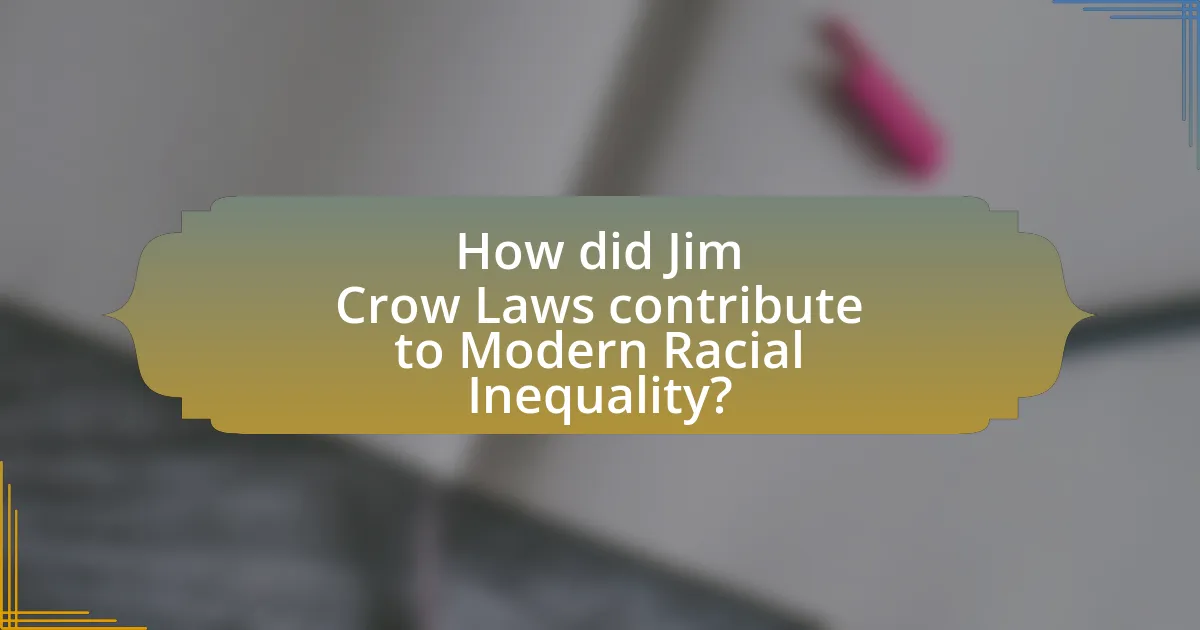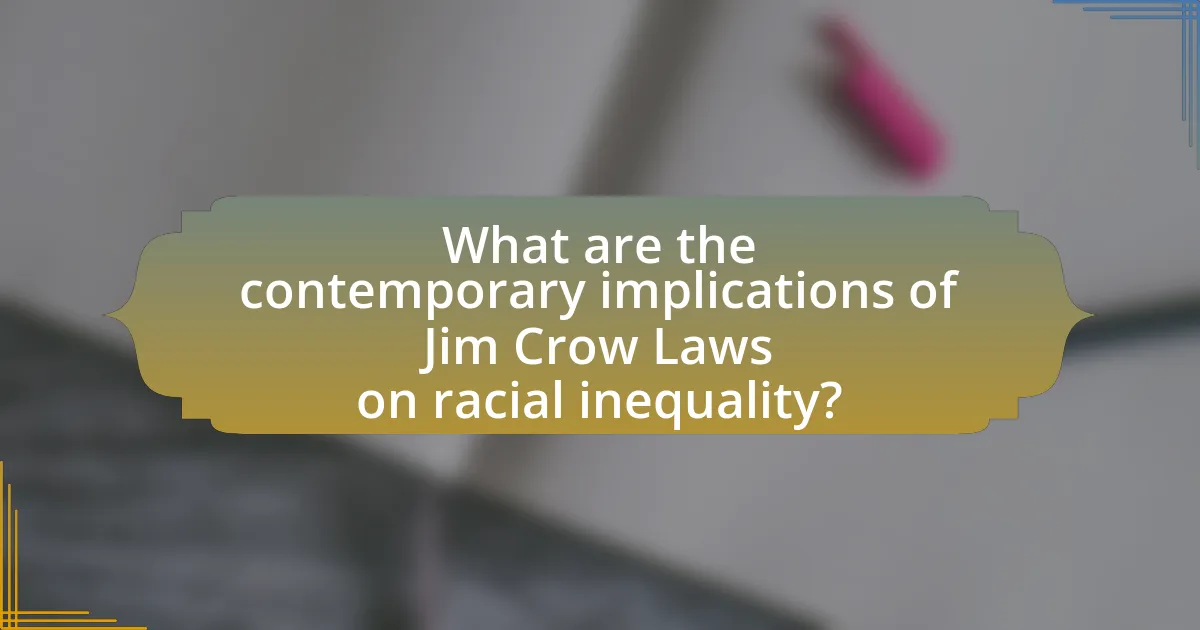Jim Crow Laws were state and local statutes enacted in the Southern United States from the late 19th century until the mid-20th century, designed to enforce racial segregation and disenfranchise African Americans. This article examines the historical context of these laws, their origins, key events leading to their establishment, and their reflection of societal attitudes of the time. It also explores the main features of Jim Crow Laws, their impact on voting rights, education, and economic opportunities for African Americans, and how their legacy contributes to modern racial inequality. Additionally, the article discusses the ongoing societal impacts of these laws, the contemporary implications for racial relations, and the steps necessary to address the enduring effects of systemic racism.

What are Jim Crow Laws and their Historical Context?
Jim Crow Laws were state and local statutes enacted in the Southern United States from the late 19th century until the mid-20th century that enforced racial segregation and disenfranchised African Americans. These laws emerged after the Reconstruction era, primarily following the 1896 Supreme Court decision in Plessy v. Ferguson, which upheld the constitutionality of racial segregation under the “separate but equal” doctrine. The historical context of Jim Crow Laws includes the post-Civil War societal shift, where white supremacy sought to maintain control over the African American population through legal means, resulting in widespread discrimination in public facilities, education, and voting rights. The implementation of these laws contributed to systemic racial inequalities that persist in various forms today.
How did Jim Crow Laws originate in the United States?
Jim Crow Laws originated in the United States as a series of state and local statutes enacted in the late 19th century, primarily after the Reconstruction era. These laws were designed to enforce racial segregation and disenfranchise African Americans, institutionalizing a system of racial discrimination. The term “Jim Crow” itself emerged from a minstrel show character in the 1830s, symbolizing the derogatory portrayal of African Americans. By the 1890s, Southern states began passing laws that mandated segregation in public facilities, schools, and transportation, following the Supreme Court’s 1896 decision in Plessy v. Ferguson, which upheld the “separate but equal” doctrine. This legal framework solidified racial inequality and laid the groundwork for systemic discrimination that persisted for decades.
What were the key events leading to the establishment of Jim Crow Laws?
The key events leading to the establishment of Jim Crow Laws include the end of Reconstruction in 1877, the Supreme Court’s decision in Plessy v. Ferguson in 1896, and the implementation of various state laws enforcing racial segregation. The end of Reconstruction marked a shift in power dynamics, allowing Southern states to enact laws that disenfranchised Black voters and enforced segregation. The Plessy v. Ferguson ruling upheld the constitutionality of racial segregation under the “separate but equal” doctrine, legitimizing discriminatory practices. Subsequently, states implemented Jim Crow Laws that institutionalized racial segregation in public facilities, schools, and transportation, solidifying systemic racism in the United States.
How did these laws reflect the social attitudes of the time?
The Jim Crow laws reflected the prevailing social attitudes of racial superiority and segregation in the late 19th and early 20th centuries. These laws institutionalized racial discrimination, demonstrating a widespread belief among white populations that African Americans were inferior and should be kept separate in all aspects of life, including education, transportation, and public facilities. For instance, the Plessy v. Ferguson decision in 1896 upheld the constitutionality of racial segregation under the “separate but equal” doctrine, reinforcing societal norms that justified discrimination and inequality. This legal framework mirrored the deeply entrenched racism of the time, as it was widely accepted by both lawmakers and the public that segregation was necessary for social order.
What were the main features of Jim Crow Laws?
The main features of Jim Crow Laws included racial segregation, disenfranchisement of Black voters, and the establishment of a legal framework that enforced white supremacy in the Southern United States. Racial segregation mandated separate facilities for Black and white individuals in public spaces such as schools, transportation, and restaurants, effectively institutionalizing inequality. Disenfranchisement tactics, including literacy tests and poll taxes, were employed to suppress Black voter registration and participation, ensuring political power remained with white citizens. These laws were upheld by the Supreme Court in cases like Plessy v. Ferguson (1896), which established the “separate but equal” doctrine, legitimizing segregation and discrimination.
What types of segregation were enforced by these laws?
The types of segregation enforced by Jim Crow laws included racial segregation in public facilities, schools, transportation, and housing. These laws mandated separate facilities for African Americans and whites, effectively institutionalizing racial discrimination. For example, the Plessy v. Ferguson case in 1896 upheld the “separate but equal” doctrine, which justified segregated public schools and transportation systems. Additionally, the Civil Rights Act of 1964 aimed to dismantle these segregation practices, highlighting their long-lasting impact on racial inequality in modern society.
How did Jim Crow Laws impact voting rights for African Americans?
Jim Crow Laws severely restricted voting rights for African Americans by implementing discriminatory practices such as literacy tests, poll taxes, and understanding clauses. These laws, enacted primarily in the Southern United States from the late 19th century until the 1960s, effectively disenfranchised a significant portion of the African American population. For instance, the Voting Rights Act of 1965 was a direct response to the systemic barriers created by Jim Crow Laws, which had resulted in less than 30% of eligible African American voters being registered in many Southern states by the early 1960s. This historical context illustrates the profound impact of Jim Crow Laws on the voting rights of African Americans, contributing to ongoing racial inequality in political representation.

How did Jim Crow Laws contribute to Modern Racial Inequality?
Jim Crow Laws significantly contributed to modern racial inequality by institutionalizing racial segregation and discrimination in various aspects of life, including education, employment, and housing. These laws, enacted in the late 19th and early 20th centuries, enforced a system that marginalized African Americans and denied them equal opportunities. For instance, the Supreme Court’s decision in Plessy v. Ferguson (1896) upheld the “separate but equal” doctrine, legitimizing segregation and reinforcing systemic barriers. The long-term effects of these laws created socioeconomic disparities that persist today, as evidenced by ongoing disparities in wealth, education, and access to resources between racial groups.
What long-term effects did Jim Crow Laws have on African American communities?
Jim Crow Laws had profound long-term effects on African American communities, including systemic economic disadvantages, educational disparities, and social segregation. These laws enforced racial discrimination and limited access to quality education and employment opportunities, leading to persistent poverty and underemployment among African Americans. For instance, the National Urban League reported that in 2019, the median household income for Black families was significantly lower than that of white families, reflecting the economic legacy of Jim Crow. Additionally, educational institutions for African Americans were often underfunded and inferior, contributing to lower educational attainment levels. This historical context has perpetuated cycles of inequality, as the effects of these laws continue to influence socio-economic conditions and access to resources in African American communities today.
How did economic opportunities change for African Americans due to these laws?
Economic opportunities for African Americans significantly declined due to Jim Crow laws, which enforced racial segregation and discrimination. These laws restricted access to quality education, limiting skill development and job prospects for African Americans. For instance, the establishment of separate and unequal schools meant that African American students received inferior education compared to their white counterparts, resulting in lower literacy rates and reduced employability. Additionally, discriminatory practices in hiring and wages further marginalized African Americans in the labor market, often relegating them to low-paying, unskilled jobs. The economic disenfranchisement created by these laws has had lasting effects, contributing to persistent racial inequality in wealth and employment opportunities today.
What role did education play in perpetuating racial inequality during and after Jim Crow?
Education played a critical role in perpetuating racial inequality during and after Jim Crow by institutionalizing segregation and limiting access to quality resources for Black individuals. Under Jim Crow laws, public education systems were racially segregated, resulting in vastly inferior facilities, curricula, and funding for Black schools compared to white schools. For example, in 1900, Black schools received only a fraction of the funding allocated to white schools, leading to overcrowded classrooms and poorly trained teachers. This systemic inequality in education not only hindered academic achievement but also reinforced social and economic disparities that persisted long after the Jim Crow era ended. The legacy of these educational inequalities continues to affect access to opportunities and resources for marginalized communities today.
Why is it important to understand the legacy of Jim Crow Laws today?
Understanding the legacy of Jim Crow Laws is crucial today because it provides insight into the systemic racism and social inequalities that persist in contemporary society. The Jim Crow Laws, enacted in the late 19th and early 20th centuries, enforced racial segregation and disenfranchised African Americans, establishing a framework of discrimination that has lasting effects. For instance, studies show that the economic disparities and educational inequalities faced by African Americans today can be traced back to the institutionalized racism of Jim Crow, which limited access to quality education and employment opportunities. Recognizing this legacy helps to inform current discussions on racial justice, policy reform, and the ongoing struggle against discrimination, making it essential for addressing modern racial inequality effectively.
How do historical injustices influence current racial disparities?
Historical injustices, such as the Jim Crow laws, significantly influence current racial disparities by establishing systemic inequalities that persist across generations. The Jim Crow laws enforced racial segregation and discrimination in the United States from the late 19th century until the mid-20th century, leading to unequal access to education, employment, and housing for African Americans. For instance, the 1930s Home Owners’ Loan Corporation redlined neighborhoods, denying loans to predominantly Black areas, which resulted in long-term disinvestment and wealth gaps. Consequently, these historical policies have created a legacy of economic disadvantage, reflected in the racial wealth gap, where the median wealth of White families is approximately ten times greater than that of Black families, according to the Federal Reserve’s 2019 Survey of Consumer Finances. Thus, the impact of historical injustices continues to shape the socio-economic landscape, perpetuating racial disparities today.
What are the ongoing societal impacts of Jim Crow Laws on modern racial relations?
The ongoing societal impacts of Jim Crow Laws on modern racial relations include systemic racism, economic disparities, and social segregation. These laws, which enforced racial discrimination and segregation from the late 19th century until the mid-20th century, have left a legacy that continues to influence contemporary issues. For instance, studies show that African Americans face significant barriers in employment and wealth accumulation, with the median wealth of Black households being significantly lower than that of white households, a disparity rooted in historical injustices. Additionally, racial profiling and police violence against Black individuals persist, reflecting the entrenched biases that originated during the Jim Crow era. The educational system also exhibits disparities, with predominantly Black schools often receiving less funding and resources, perpetuating cycles of inequality. These factors collectively illustrate how the remnants of Jim Crow Laws continue to shape racial relations and inequalities in modern society.

What are the contemporary implications of Jim Crow Laws on racial inequality?
The contemporary implications of Jim Crow Laws on racial inequality include systemic discrimination and socio-economic disparities that persist in various sectors such as education, employment, and criminal justice. These laws, which enforced racial segregation and disenfranchisement from the late 19th century until the mid-20th century, have left a legacy that continues to affect African American communities today. For instance, studies show that predominantly Black neighborhoods often face underfunded schools, limited job opportunities, and higher rates of incarceration, reflecting the long-term effects of segregationist policies. According to the Economic Policy Institute, Black workers earn significantly less than their white counterparts, a disparity rooted in historical injustices including Jim Crow. This ongoing inequality highlights the need for continued efforts to address the structural barriers that originated from these discriminatory laws.
How do modern policies reflect the legacy of Jim Crow Laws?
Modern policies reflect the legacy of Jim Crow Laws through systemic racial discrimination and socioeconomic disparities that persist in areas such as housing, education, and criminal justice. For instance, policies like voter ID laws and gerrymandering disproportionately affect minority communities, echoing the disenfranchisement tactics used during the Jim Crow era. Additionally, redlining practices in housing continue to limit access to quality neighborhoods for people of color, a direct descendant of the segregationist policies of the past. Studies show that these modern practices contribute to ongoing racial inequality, with African Americans facing higher rates of poverty and incarceration compared to their white counterparts, illustrating the enduring impact of Jim Crow Laws on contemporary society.
What examples exist of systemic racism in today’s legal and social systems?
Systemic racism in today’s legal and social systems is exemplified by disparities in criminal justice outcomes, housing policies, and educational opportunities. For instance, Black Americans are incarcerated at more than five times the rate of white Americans, as reported by the NAACP, highlighting racial bias in law enforcement and sentencing practices. Additionally, redlining practices, which were institutionalized during the Jim Crow era, continue to affect home ownership rates; a study by the Urban Institute found that Black families are still less likely to own homes compared to white families, perpetuating wealth inequality. In education, schools in predominantly Black neighborhoods often receive significantly less funding than those in predominantly white areas, as evidenced by a report from the Education Trust, which shows that schools serving low-income students of color receive about $23 billion less in funding than schools serving white students. These examples illustrate how systemic racism persists in various facets of society, rooted in historical injustices.
How do economic inequalities today trace back to Jim Crow Laws?
Economic inequalities today can be traced back to Jim Crow Laws through systemic disenfranchisement and segregation that limited African Americans’ access to quality education, employment, and wealth accumulation. Jim Crow Laws enforced racial segregation and discrimination, which created barriers to economic opportunities for Black individuals, leading to generational poverty. For instance, the Federal Reserve reported in 2020 that the median wealth of Black families is significantly lower than that of white families, a disparity rooted in historical injustices including the denial of property ownership and access to quality jobs during the Jim Crow era. This historical context illustrates how the legacy of these laws continues to perpetuate economic disparities in contemporary society.
What steps can be taken to address the impacts of Jim Crow Laws on racial inequality?
To address the impacts of Jim Crow Laws on racial inequality, implementing comprehensive policy reforms is essential. These reforms should include enacting anti-discrimination laws that protect against racial bias in employment, housing, and education, thereby ensuring equal opportunities for all individuals regardless of race. Historical evidence shows that Jim Crow Laws institutionalized systemic racism, leading to significant disparities in wealth, education, and health outcomes for African Americans. For instance, the U.S. Census Bureau reported that in 2019, the median household income for Black families was approximately 61% of that for White families, highlighting ongoing economic inequality rooted in historical injustices. Additionally, investing in community development programs and education initiatives can help to dismantle the lingering effects of segregation and promote social equity. These steps are crucial for fostering a more inclusive society and rectifying the historical injustices perpetuated by Jim Crow Laws.
What role does education play in combating the legacy of Jim Crow Laws?
Education plays a crucial role in combating the legacy of Jim Crow Laws by promoting racial equality and social justice. Through education, individuals gain awareness of historical injustices and develop critical thinking skills necessary for challenging systemic racism. For instance, studies show that higher educational attainment correlates with increased civic engagement and advocacy for civil rights, as seen in the Civil Rights Movement where educated leaders like Martin Luther King Jr. emerged. Furthermore, educational initiatives aimed at inclusivity and diversity help dismantle stereotypes and foster understanding among different racial groups, thereby addressing the societal divisions created by Jim Crow Laws.
How can communities work towards racial equity in light of historical injustices?
Communities can work towards racial equity by actively addressing the systemic inequalities rooted in historical injustices, such as those perpetuated by Jim Crow laws. This can be achieved through initiatives like implementing equitable policies in education, housing, and employment, which directly counteract the long-term effects of segregation and discrimination. For instance, research from the National Bureau of Economic Research indicates that areas with policies promoting affordable housing and equitable school funding see improved outcomes for marginalized communities. Additionally, community engagement in dialogues about racial history and its impact fosters awareness and accountability, leading to collective action for change.
What resources are available for understanding and addressing racial inequality?
Resources available for understanding and addressing racial inequality include academic research, government reports, and community organizations. Academic research, such as “The Color of Law” by Richard Rothstein, provides historical context on segregation and its lasting effects. Government reports, like the U.S. Commission on Civil Rights’ “The Economic Impact of Racial Inequality,” offer statistical analysis and policy recommendations. Community organizations, such as the NAACP and the Urban League, provide advocacy, education, and resources for addressing racial disparities. These resources collectively enhance understanding and inform strategies to combat racial inequality.


